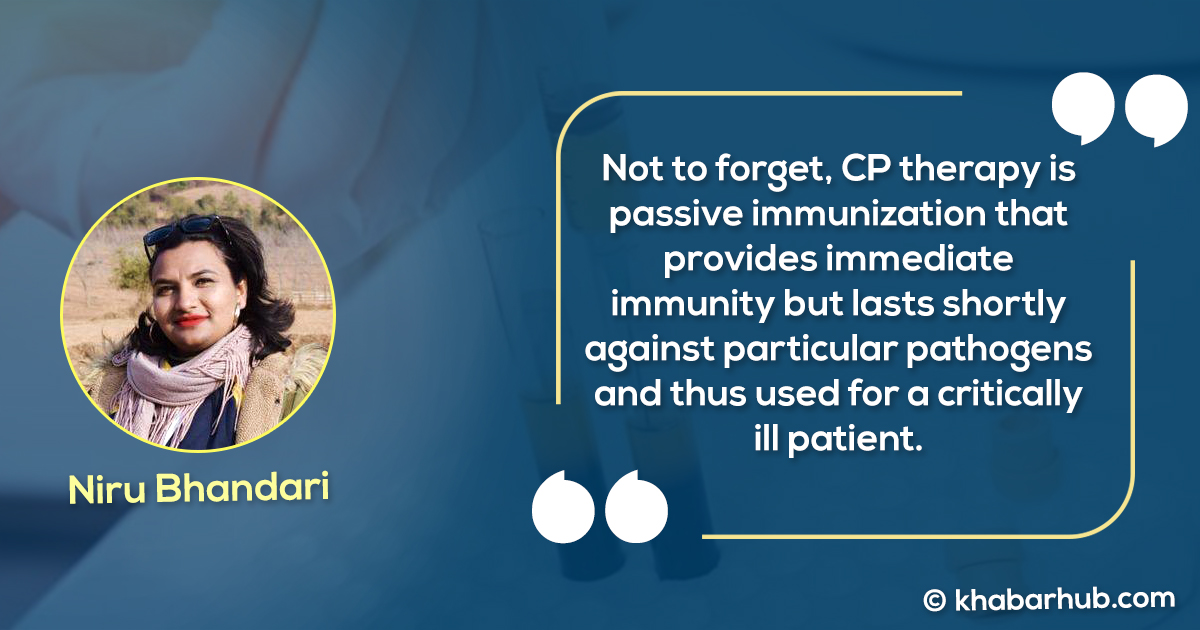The human body has amazing machinery when it comes to fighting against external agents that cause disease or any sort of malfunctioning of the body which is known to be an immune response.
Isn’t this fascinating, even the blood we have can be used to treat a disease? The very recent and popular example used to cure SARS-CoV-2 in Nepal is Convalescent Plasma (CP) Therapy.
Even though it has been often said that the vaccines are the ultimate goal for SARS-CoV-2, the use of CP therapy can’t be denied.
CP therapy was one of the prior treatments used in both neighboring countries India and China. Though CP therapy was lately conducted in Nepal, this therapy is showing promising results in the treatment of seriously ill SARS-CoV-2 patients.
Meanwhile, can this therapy turn out to be a black horse in long run is yet to be observed in near future?
There is no standard transfusion dose for CP therapy. From different studies, the administration of CP is found to range between 200 and 500 mLin single or double scheme dosages for SARS-CoV-2.
To start plasma is the clear, straw-colored liquid portion of blood that remains after the red blood cells, white blood cells, platelets and other cellular components are removed, comprising 55% of total human blood that contains water, salts, enzymes, antibodies and other proteins.
Hence CP therapy is the administration of blood plasma of patients who have recovered from infection recently to seriously ill patients.
The basic science behind CP therapy concerning SARS-CoV-2 is that a person infected with SARS-CoV-2 naturally generates antibodies against the virus in their blood plasma, which makes their blood plasma equivalent to drugs against the same infection.
CP Therapy is classic adaptive immunotherapy that has been applied to the prevention and treatment of many infectious diseases for more than one century started with established CP infusion in the 1880s for diphtheria.
During that phase, it was recognized that immune plasma not only neutralizes the pathogen but also provides passive immunomodulatory properties that allow the recipient to control the excessive inflammatory cascade induced by several infectious agents or sepsis.
Over the past two decades, CP therapy was successfully used in the treatment of SARS, MERS, and the 2009 H1N1 pandemic with satisfactory efficacy and safety with a reduction in fatality rate, mortality and mild adverse events.
The next question in a row is what kind of blood is suitable for CP therapy in SARS-CoV-2 treatment. Currently, convalescent donors between 18 and 65 are considered as subjects without infectious symptomatology and negative test for SARS-CoV-2 after 14 days of recovery without any other infection.
Most of these convalescent donors have a healthy number of antibodies but sufficient antibody production is not universal.
Apheresis, continuous centrifugation of blood from a donor is used to collect sufficient plasma. Around 400 to 800mL of plasma can be collected from single apheresis donation which can be stored in units of 200 or 250mL, and frozen within 24 hours of collection to be used for further transfusion.
These immunoglobulins contribute to prophylaxis and/or recovery improvement. There are numerous case studies conducted across the globe to study the mechanism and effect of CP therapy.
Thus obtained blood plasma is used in newly infected patients who don’t have antibodies to fight against SARS-CoV-2, seriously ill with suspected pneumonia, symptoms of persistent cough and/or breathlessness along with a continuous requirement of oxygen.
There is no standard transfusion dose for CP therapy. From different studies, the administration of CP is found to range between 200 and 500 mLin single or double scheme dosages for SARS-CoV-2.
Currently, the recommendation is to administrate 3mL/kg per dose in two days. This strategy facilities the distribution of plasma units (250 mL per unit) and provide a standard option of delivery in public health strategies.
Once the convalescent plasma is administered in an infected person various immune responses come in action.
The recipient receives neutralizing antibodies, other proteins, anti-inflammatory cytokines, clotting factors, natural antibodies, defensins, pentraxins and other undefined proteins from donor plasma.
Neutralizing Antibodies (NAbs) present in blood plasma plays a crucial role in virus clearance through inhibition in the entry of the virus by binding with the receptor-binding protein of viruses and thus limiting viral amplification.
Moreover, other antibody-mediated pathways such as complement activation, antibody-dependent cellular cytotoxicity and/or phagocytosis may also promote the therapeutic effects of CP. In addition to NAbs there are other protective antibodies including immunoglobulin G (IgG) and immunoglobulin M (IgM).
These immunoglobulins contribute to prophylaxis and/or recovery improvement. There are numerous case studies conducted across the globe to study the mechanism and effect of CP therapy.
In instance, a case study conducted by Shen, et al. in 5 critically ill patients of SARS-CoV-2 and acute respiratory distress syndrome treated with CP Therapy in Shenzhen Third Peoples Hospital in Shenzhen, China from January to March 2020, showed that in convalescent donors SARS-CoV-2-specific antibody titers range between 1.800 to 16.200 and NAbs titers in between 80 and 480 and such plasma when transfused in the critically ill patient showed a decrease in viral load in the same day of administration.
CP therapy outcomes can surely encourage the recovered SARS-CoV-2 patients to donate their plasma if they are made aware of effective medical help their blood plasma can be for others in this pandemic.
Also, other various researches have shown improvement in clinical symptoms in critically ill patients within 1-3 days, reduction of pulmonary lesions on chest CT examinations, improvement of pulmonary functions, increase in NAbs titer in recipient along with the disappearance of SARS-CoV-2 RNA.
All these suggesting the effectivity of CP therapy in the treatment of the severely ill patient from SARS-CoV-2.
However, in most of the studies conducted in China and South Korea along with CP therapy, the use of antiviral drugs is reported suggesting the combined effect of antiviral drugs and CP therapy in treatment.
On the other hand, 12 hospitals in Nepal are allowed for CP therapy and most of the cases with complications undergoing CP therapy are showing positive outcomes.
Not to forget, CP therapy is passive immunization that provides immediate immunity but lasts shortly against particular pathogens and thus used for a critically ill patient.
CP therapy outcomes can surely encourage the recovered SARS-CoV-2 patients to donate their plasma if they are made aware of effective medical help their blood plasma can be for others in this pandemic.
(Views expressed in this article are the author’s own and do not necessarily reflect Khabarhub’s editorial stance)









Comment